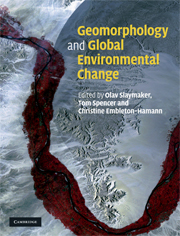Book contents
- Frontmatter
- Contents
- List of contributors
- Preface
- Acknowledgements
- List of acronyms and abbreviations
- 1 Landscape and landscape-scale processes as the unfilled niche in the global environmental change debate: an introduction
- 2 Mountains
- 3 Lakes and lake catchments
- 4 Rivers
- 5 Estuaries, coastal marshes, tidal flats and coastal dunes
- 6 Beaches, cliffs and deltas
- 7 Coral reefs
- 8 Tropical rainforests
- 9 Tropical savannas
- 10 Deserts
- 11 Mediterranean landscapes
- 12 Temperate forests and rangelands
- 13 Tundra and permafrost-dominated taiga
- 14 Ice sheets and ice caps
- 15 Landscape, landscape-scale processes and global environmental change: synthesis and new agendas for the twenty-first century
- Index
12 - Temperate forests and rangelands
Published online by Cambridge University Press: 05 July 2015
- Frontmatter
- Contents
- List of contributors
- Preface
- Acknowledgements
- List of acronyms and abbreviations
- 1 Landscape and landscape-scale processes as the unfilled niche in the global environmental change debate: an introduction
- 2 Mountains
- 3 Lakes and lake catchments
- 4 Rivers
- 5 Estuaries, coastal marshes, tidal flats and coastal dunes
- 6 Beaches, cliffs and deltas
- 7 Coral reefs
- 8 Tropical rainforests
- 9 Tropical savannas
- 10 Deserts
- 11 Mediterranean landscapes
- 12 Temperate forests and rangelands
- 13 Tundra and permafrost-dominated taiga
- 14 Ice sheets and ice caps
- 15 Landscape, landscape-scale processes and global environmental change: synthesis and new agendas for the twenty-first century
- Index
Summary
Introduction
12.1.1 Hydrological and geomorphic processes in temperate forests and rangelands
Long-term experiments in forest hydrology, often using the paired catchment approach, have shown the striking dependence of stream flow volume on type of vegetation cover. The main change following forest clearance is an increase in storm flow volume on the falling limb of the storm hydrograph; as volumes of storm runoff from many headwater catchments converge lower down the stream network, extensive and serious flooding of lowlands can occur. These problems are exacerbated by the land degradation that follows clearcutting of forest and it is this land degradation and its catastrophic consequences through mass movements which form the core of this chapter.
Landslides are one of the major geomorphic processes affected by land use and climate change in mid-latitude temperate forests and rangelands. Inherent in these discussions are potential changes in hydrological processes that either drive or influence landslides, as well as issues such as land degradation. Landslides are typically episodic and not only impact stream channels and decrease site productivity, but also represent formidable hazards to humans and property. Surficial or slow-moving landslides contribute sediment to streams, decrease site productivity and may damage property, but do not typically endanger people (Sidle and Ochiai, 2006).
Mid-latitude forest and rangeland ecosystems are constantly changing as the result of human activities, movement of population sectors, climate change, and most recently a surge in information technology. This last development is important because it affects public perception of these geomorphic changes and hazards. Given the current easy access to such information, it is imperative that scientists, land managers and planners provide accurate, rational and timely information and assessments on environmental change issues to the public (Sorensen, 2000). Neither apocalyptic nor ‘business as usual’ scenarios of climate change and forest land use are in the best public interest.
- Type
- Chapter
- Information
- Geomorphology and Global Environmental Change , pp. 321 - 343Publisher: Cambridge University PressPrint publication year: 2009
- 8
- Cited by



